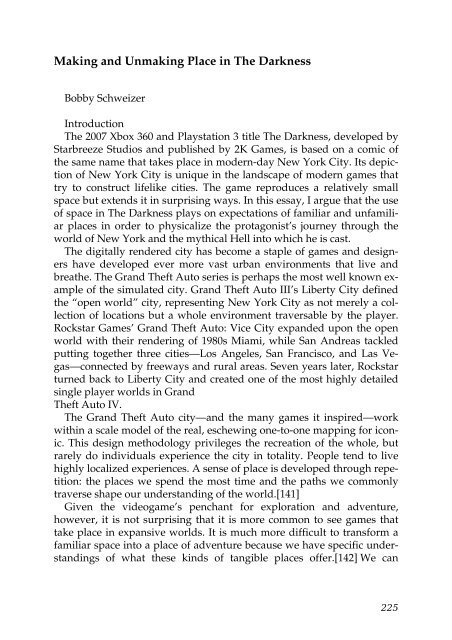Well Played 2.0: Video Games, Value and Meaning - OpenLibra
Well Played 2.0: Video Games, Value and Meaning - OpenLibra
Well Played 2.0: Video Games, Value and Meaning - OpenLibra
Create successful ePaper yourself
Turn your PDF publications into a flip-book with our unique Google optimized e-Paper software.
Making <strong>and</strong> Unmaking Place in The Darkness<br />
Bobby Schweizer<br />
Introduction<br />
The 2007 Xbox 360 <strong>and</strong> Playstation 3 title The Darkness, developed by<br />
Starbreeze Studios <strong>and</strong> published by 2K <strong>Games</strong>, is based on a comic of<br />
the same name that takes place in modern-day New York City. Its depiction<br />
of New York City is unique in the l<strong>and</strong>scape of modern games that<br />
try to construct lifelike cities. The game reproduces a relatively small<br />
space but extends it in surprising ways. In this essay, I argue that the use<br />
of space in The Darkness plays on expectations of familiar <strong>and</strong> unfamiliar<br />
places in order to physicalize the protagonist’s journey through the<br />
world of New York <strong>and</strong> the mythical Hell into which he is cast.<br />
The digitally rendered city has become a staple of games <strong>and</strong> designers<br />
have developed ever more vast urban environments that live <strong>and</strong><br />
breathe. The Gr<strong>and</strong> Theft Auto series is perhaps the most well known example<br />
of the simulated city. Gr<strong>and</strong> Theft Auto III’s Liberty City defined<br />
the “open world” city, representing New York City as not merely a collection<br />
of locations but a whole environment traversable by the player.<br />
Rockstar <strong>Games</strong>’ Gr<strong>and</strong> Theft Auto: Vice City exp<strong>and</strong>ed upon the open<br />
world with their rendering of 1980s Miami, while San Andreas tackled<br />
putting together three cities—Los Angeles, San Francisco, <strong>and</strong> Las Vegas—connected<br />
by freeways <strong>and</strong> rural areas. Seven years later, Rockstar<br />
turned back to Liberty City <strong>and</strong> created one of the most highly detailed<br />
single player worlds in Gr<strong>and</strong><br />
Theft Auto IV.<br />
The Gr<strong>and</strong> Theft Auto city—<strong>and</strong> the many games it inspired—work<br />
within a scale model of the real, eschewing one-to-one mapping for iconic.<br />
This design methodology privileges the recreation of the whole, but<br />
rarely do individuals experience the city in totality. People tend to live<br />
highly localized experiences. A sense of place is developed through repetition:<br />
the places we spend the most time <strong>and</strong> the paths we commonly<br />
traverse shape our underst<strong>and</strong>ing of the world.[141]<br />
Given the videogame’s penchant for exploration <strong>and</strong> adventure,<br />
however, it is not surprising that it is more common to see games that<br />
take place in expansive worlds. It is much more difficult to transform a<br />
familiar space into a place of adventure because we have specific underst<strong>and</strong>ings<br />
of what these kinds of tangible places offer.[142] We can<br />
225

















